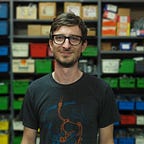Lines in the Pavement
This photo may not look like much, but it means a lot to me. For the past year, the City and the Upper State Street Association have been working together to make State Street better. This is a photo that shows newly painted parking spots on State Street where there were none before. Those lines are the result of over a year of negotiating, learning to trust, and believing in ways forward.
State Street is a vibrant district with a diverse collection of businesses and residents. During the day, people can be seen waiting in line for brunch at The Pantry, picking up flowers at Fleur de Lys, grabbing lunch at Chestnut Fine Foods or Jordan’s Hot Dogs and Mac, getting a haircut at the many salons and barber shops, picking up trophies at Dinn, getting groceries at Tlaxcala or State Fish, and sipping coffee at Coffee Pedaler. In the evening, it is a bustling mix of locals and out-of-towners getting pizza at Da Legna or Modern, getting dinner at L’Orcio, beers at Christopher Martins, wine at August or Cave a’ Vin, cocktails at Oak Haven, and late night fries at Order of Fries. Yes, that was a laundry list, and yes, State Street has a laundromat too. There are over 70 businesses on the 1-mile section of Upper State Street, and no two are the same.
State Street has a parking problem. The street is hemmed in by the highway, there are no public lots, parking in the adjacent residential neighborhood is resident-only, there are a lot of businesses close together, and parking on State Street is mostly 2-hour. A study done recently shows that there are approximately 132 available on-street spots on State Street, but there is a need for 389 spots based on properties’ and businesses’ zoning requirements.
Late in 2016, I was having coffee with Ben Berkowitz and he mentioned that I should re-instate the Upper State Street Association, a group of business owners and property owners on State Street from Bradley Street to James Street (overpass to overpass) who organized street and community improvements like sidewalk cleanups and farmer’s markets. Being a new business owner on the street and wanting to meet more neighbors, I agreed, and some emails were sent out.
When Ben introduced me via email in November of 2016 to some of the former USSA organizers, we both immediately received a flurry of replies not about the prospect of bringing it back to life, but about the need to do so. Part of this energy came in response to a proposal from the city to install parking meters on State Street. Most businesses were concerned, if not flat out against it. The first few USSA meetings were rowdy. There was a lot of confusion about the proposal, plenty of disagreement about what should be done, and some yelling at the Association’s head of Economic Development. Somehow during all of this, I was elected co-president along with Alison from L’Orcio. I thought I was helping resuscitate a group to plant flowers and install some benches, but I had walked straight into a political fist fight.
Most businesses on State Street were against parking meters. Many rely on out-of-town customers and worried that meters would deter them; the scarcity of parking was already bad enough — no need to force customers to pay for it as well.
The City’s Office of Economic Development and Department of Transportation, Traffic & Parking were in favor of parking meters. They cited data that showed meters increased turnover of parking spots and increased revenue for the street to do needed infrastructure improvements, like street lighting and repaving.
Over the nine months that followed those first few impassioned meetings, both sides sat down on opposite sides of the table (literally) and worked together to find common ground. Often it was hard to listen, to trust, and to try to build. Some meetings ended with forced smiles and a slow trudge back home. But other meetings saw progress and optimism. We focused on the things that we agreed on — reworking the bus stops, cleaning up the collection of outdated signage and restrictions, moving loading zones, and striping the parking spots — and put the rest on the back burner.
Fast forward to August of 2017. Carlos Eyzaguirre (Office of Economic Development), Bruce Fischer (City Traffic Engineer), and I were walking the street on one of the nicest days of the year, mapping out spots and SeeClickFix’ing various things along the way. Two weeks later, you see what I see:
Those lines in the street are freshly painted and help cars park more efficiently. They are simple and small. They don’t magically fix our problems, they don’t save the world. They are only one step forward and there is still a long way to go. But they mean a lot to me, because they represent two sides putting aside their differences and building something together. Everyone sitting at the table believed in a better New Haven and they put that first. Those lines make me proud of my city.
